Achatina snails: care and maintenance. How to feed Achatina at home. All types of Achatina: African, giant
The city dwellers give birth to everyone as pets! Quiet and generally unpretentious giant Achatina snails have become very popular recently. The maintenance and care of these wordless creatures is quite simple, no more difficult than a turtle. What do you need to know for a beginner who decides to breed clams? Pet shop sellers often cannot clearly explain to the buyer all the subtleties of caring for Achatina. Read on for tips on feeding and keeping these beauties from the Black Continent.
Choosing our pet
Giant African snails, which are bred as pets in Europe and Russia, are considered terrible and gluttonous pests in their homeland, capable of destroying sugarcane and other agricultural crops in the bud. Scientists attribute the land gastropod mollusk to the large family Archachatinidae. It includes several genera and about sixty species. Representatives of the Arkhahatina genus have a blunt rounded crown of the shell, they are considered more primitive in comparison with the Achatina. They are also sold in pet stores, especially Archachatina marginata, whose house can be up to twelve centimeters in diameter. African Achatina differs from its relative by the pointed and elongated crown of the shell. She also has an outgoing personality.
What are Achatina
But even within this genus there are many species. If you're after size, get the West African Achatina achatina - the largest snail. Achatina giant in the wild grows its shell up to thirty-seven centimeters in length, and the weight of the mollusk can be 450 grams. In captivity, they are slightly smaller, but they look no less impressive. She is considered the most prolific, by the way, and the most unpretentious. Eats everything, feels great in an ordinary city apartment. But these creatures are uncommunicative and slow.
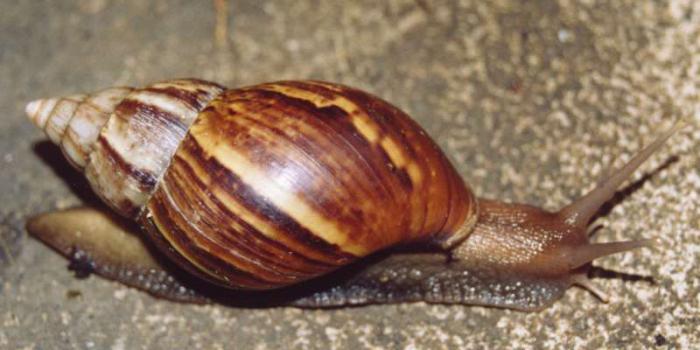
Achatina reticulates, on the contrary, are very mobile. We can say that these mollusks are curious, sociable, quick-witted. Their shells, covered with a dotted or striped pattern, can be up to 20 cm in diameter. Among breeders, albino reticulates are most appreciated, they are less, but insanely beautiful. Achatina iredalei, or lemon Achatina, is interesting because it is viviparous. The snail brings up to 25 babies in one litter. Its light yellow carapace is rather small, it is only five centimeters in an adult.
Does the choice of the Achatina species change the care and maintenance of the pet? In fact, all these African snails are relatives, and close ones. Therefore, they all have almost the same requirements for food, temperature and humidity. Some like wetter environments, others like dry environments. Someone buries in the ground during the day and crawls out unsociably only at night, while representatives of other species trustingly crawl into the palm of the owner. But, by and large, the basic techniques of care and feeding for all types of Achatina are the same. When choosing a pet, be guided only by your aesthetic feelings. Let its bright and unusual color delight your eyes and improve your mood! 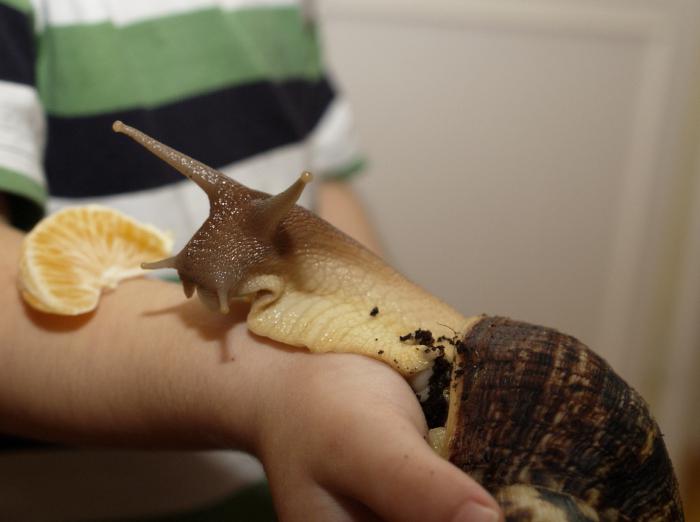
Terrarium
A snail is not a crocodile or even a python, so a house for it may be the most ordinary one. It could be a glass aquarium, but not filled with water, of course. It can also be a container made of transparent or translucent plastic, a plexiglass terrarium. You should take care of enough space for your pet, the capacity should be at least five liters for one snail. If you decide to breed three or four Achatina at once, their maintenance requires a 20-liter aquarium or box. And since molluscs are not fish, they can arbitrarily leave the place allocated for them and crawl around the apartment. To prevent this from happening, cover the terrarium with a lid, in which make enough holes for free air circulation.
We equip the house
On the bare bottom of the aquarium or container, Achatina snails will feel uncomfortable, stop growing, and start to wither. That is why a soil is needed where the pets could bury themselves. Ideally, an orchid or orchid can serve as such bedding. Small snails can suffocate in too dense cover. You can use Begonia substrate (available in florist shops) or compost without fertilizer.
The right bedding
Do not pour peat and loam, after a while you will watch your soiled pets through glass, no less worn out in the mud. The good thing about sand is that it encourages snails to lay their eggs. But Achatina, which is otherwise very simple to care for and maintain, can carry grains of sand throughout the terrarium and scratch each other's glass and shells. In general, here you need to empirically find the "golden mean". The substrate should not be completely organic either, because fruit flies can start in the compost, which will fly throughout the apartment. Knowledgeable snail breeders advise creating a bedding from a mixture of coarse loose sand and non-acidic soil.
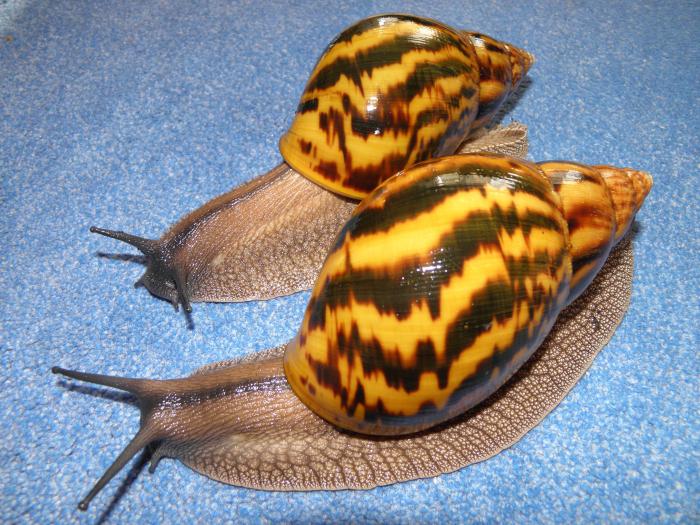
Water procedures
Achatina snails love to splash around, so make sure to install a tub in your cage and fill it with fresh, room temperature water. If you hatch young, make sure that the bath is shallow enough. In general, these African snails move well under water, but a small individual can accidentally choke. The bath should stand firmly at the bottom so that if some Achatina decides to undermine the litter under it, the water does not spill.
Aesthetic design
A beautiful diamond needs a decent setting, as the saying goes. And if such precious stones are Achatins? The care and maintenance of these beauties is simply unthinkable without the aesthetic design of the terrarium. Non-rotting pieces of wood, moss, terracotta shards will only emphasize the sophistication of African snails. Plants will not only look spectacular in the terrarium, but also saturate it with oxygen, and at the same time diversify the diet of your pets. The most optimal neighbors for Achatina will be fern and ivy.
Temperature regime
Giant snails are inhabitants of the hot tropics. Therefore, the temperature in the terrarium should range from +20 to + 28 Celsius. Do not put the container with snails near the battery, this leads to overdrying of the substrate. Direct sunlight is also undesirable, in this case, an undesirable temperature contrast awaits the snails. If your home is colder in the winter, use a reptile-style heating lamp to maintain an optimal climate in your cage. Achatins are more or less indifferent to the light, they do not need to extend the "day", as for orchids. But it is important to move the light source outside the container so that the snails do not try to crawl over the lamps.
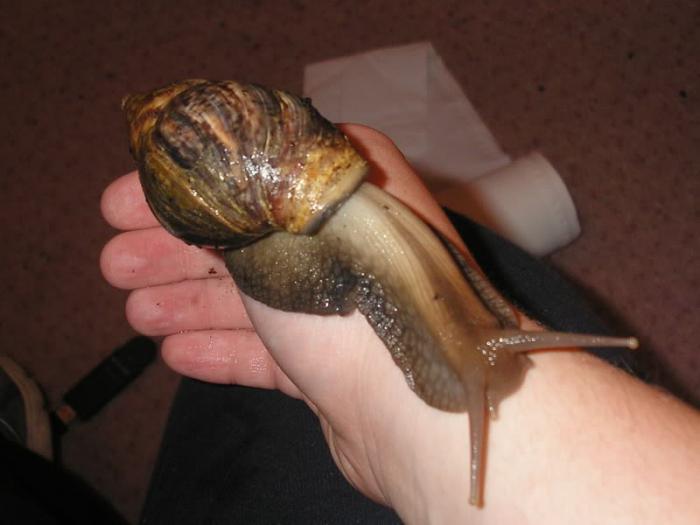
Humidity
These natives of the equatorial jungle love humid environments. Therefore, you need to spray the bedding and the walls of the enclosure with water from a spray bottle once or twice a day. inside the box should fluctuate, depending on the type of your Achatina, from 75 to 85 percent. And the albopicta snail (in appearance resembles a reticulum) generally needs 90% moisture. The optimal hydration regimen should also be sought empirically. Sprinkle the terrarium without excessive fanaticism, as you will dilute the swamp and mud. If you see that most snails are sitting on the walls and trying to climb higher, then the environment is too humid for them. If they burrow into the ground even in the evening, are clogged with lids, then the terrarium is too dry.
What to feed Achatina
This point worries many novice snail lovers. Do not be afraid, because the Achatins eat our "domestic" vegetables and fruits very well. Unlike other exotic plants, they can easily live without papaya, bamboo sprouts, fresh eucalyptus leaves and other things. Most breeders identify three products that Achatina adore. These are lettuce leaves, fresh cucumber and apple. However, they should not be limited to these products only. For the health and longevity of snails, you should diversify their menu. Give them carrots and cabbage leaves as well. Achatina do not like potatoes too much, except perhaps boiled. Indulge your snails with a variety of berries and fruits in summer. However, do not give soft fruits to the young. There were cases when young snails completely buried themselves in a banana and suffocated there. Achatina tomatoes, spinach, mushrooms, legumes, zucchini, as well as melon and watermelon will be appreciated. But what snails can't do is spicy, fried, smoked, sweet.
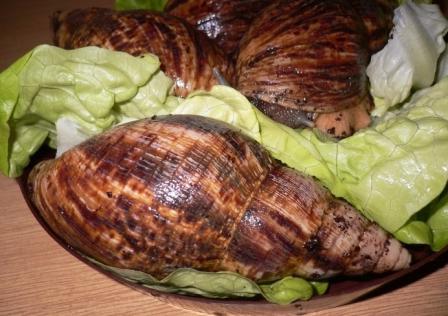
Mineral supplements
Calcium is an important component that Achatina desperately need. Care and maintenance of snails provides for regular feeding. In addition, you can provide them with the necessary "building material" for the shell in the form of mashed eggshell, sepia, shell rock, gammarus, cottage cheese (without salt and other food additives). Occasionally give your pets a calcium porridge (a mixture of grains and minerals). Do not forget that in the wild, Achatina do not disdain carrion. Therefore, occasionally you can give them mashed potatoes, boiled eggs, minced meat. If the snail does not get enough calcium, its shell becomes thinner. Consequently, her internal organs, which are attached to the inner side of the shell, become vulnerable.
Reproduction
Domestic snails Achatina are extremely fertile. In addition, they are hermaphrodites and can bear offspring, regardless of the presence of a heterosexual partner. If you do not want a new offspring, just wash off the eggs (they look like chicken eggs, only in miniature) with water. But if you want to breed snail offspring, you should be careful with the cleaning of the terrarium. It should be cleaned so as not to change the humidity of the air and not to damage the masonry. To prevent newborn Achatina from suffocating in the loose soil of the litter, you need to keep them on lettuce or cabbage leaves.
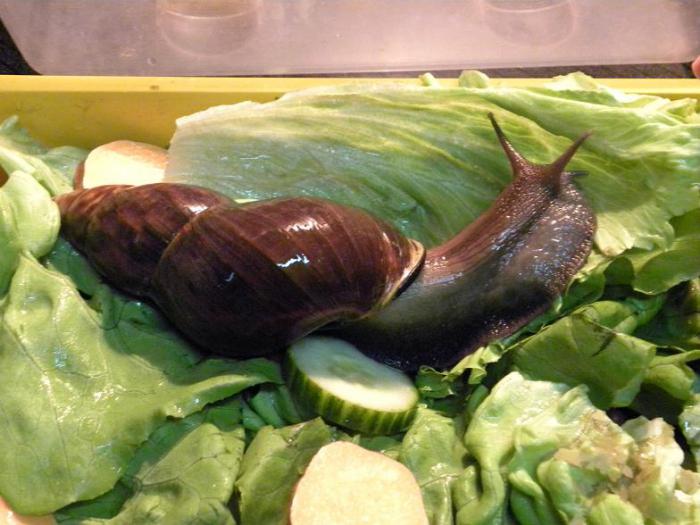
Diseases and care of snails
The most common problem breeders face is carapace injuries. Very often, crawling on the cover of the terrarium, the snail falls off and falls down. Sometimes the landing is very unsuccessful and results in the shell chipping or cracking. Don't panic right away. If the soft body does not fall out, or if it protrudes quite a bit, the matter is fixable. Just grease the chip with an antiseptic. The rest will be done by the strong organism of the snail. The wound healing process will start soon. Maybe the shell won't be so beautiful, but the pet is alive. For the duration of therapy, move the wounded Achatina to a separate box, since the snails are very fond of rubbing their shells against each other.
